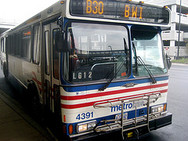Infrequent airport buses offer a lackluster welcome
There are a variety of ways to get to Washington’s 3 airports. By far the most convenient way from downtown is to take Metro to nearby National Airport. But Metro does not make it out to Dulles or BWI International Airports.
Passengers arriving on international flights face a lengthy ride into Washington from either airport, but the length itself is not the only impediment for people to take transit to or from Dulles and BWI. Bus capacity and frequency are both major issues facing airport-bound passengers. While other major cities, both domestically and abroad, link their international air gateways to the city by bus, few make passengers wait as long between buses or leave them wondering how they’re going to fit aboard.
The B30 links Greenbelt Station with BWI Airport. It runs approximately every 40 minutes every day of the week, including Saturday and Sunday. During the work week, there are four additional trips, due to the fact that Metro opens earlier. The bus leaves Greenbelt for BWI 25 times Monday through Friday and 21 times on Saturday and Sunday. It takes about 30 minutes to reach the airport.
Dulles is connected by the 5A, which runs from L’Enfant Plaza to Rosslyn and then on to Dulles Airport, making a few stops in the corridor. Trips during the week have an average headway of just under 40 minutes, with buses coming every 60 minutes on weekends. Each working day sees 30 trips to and from the airport in each direction, while only 18 are made on Saturdays and Sundays. The 5A can take over an hour to get from Dulles to L’Enfant Plaza.
As we are all aware, each bus has a finite capacity. According to WMATA, the average capacity for a 40-foot bus (pictured above) is 41 seats with a total of 71 passengers. Metro also operates 60-foot, articulated buses. These have a seating capacity of 57 and an overall capacity of 91. Of course, those numbers are typical for commuters, who don’t regularly carry bags and suitcases. Bus capacity can also be limited by the experience level of riders. Novice riders don’t always move back, and sometimes sit on the aisle seat, leaving a vacant or bag-filled seat by the window. And some buses serving the airports have luggage racks, which further limit seating capacity.
Suffice it to say that the buses serving Dulles and BWI have a capacity that is at least a little lower than the normal averages.
But let’s assume that each bus could carry the maximum number of people. Even with that stipulation, the airport bus lines have a surprisingly low capacity.
To put those numbers in perspective, one railcar can carry about 70 seated passengers or 175 seated and standing passengers when full. That means that an 8-car train can carry about 1,400 people. One full 8-car train can has a higher capacity than all the 5A buses, combined, running from Washington to Dulles Airport on a Saturday or Sunday, if they’re all 40-footers. Two 8-car trains would be more than enough to carry all of the weekday buses, even if they were all 60-footers.
During the holiday seasons, around Thanksgiving and Christmas, WMATA operates extra buses on both lines. This helps to ensure that someone doesn’t have to wait 40 minutes on the next bus if they can’t fit aboard the first one. But just last week, I saw airport-bound travelers left at Greenbelt because the B30 filled up before they could get on. Even with supplemental buses, passengers fret. After Thanksgiving, when my flight arrived at BWI, I hurried over to the stop outside Concourse E. The first bus, a 40-footer, came and filled up. Less than half of the people at the stop made it. The bus driver announced that an extra bus was “just behind her,” and 10 minutes later, a 60-foot articulated bus arrived. Everyone did manage to climb aboard, but there was only room for about 5 or 6 more patrons.
For passengers arriving in our nation’s capital for the first time, whether from Paris or Kansas City, the long bus rides are made torturous by overcrowding and long wait times.
In Berlin, on the other hand, the TXL JetExpress bus runs every 10 minutes weekdays and every 20 minutes on weekends. It connects Tegel Airport to the city center in under 40 minutes, and reaches its first rail connection within 10 minutes of leaving the airport.
In the face of today’s budget crisis, however, it seems unlikely that Metro will be expanding service anytime soon. But WMATA needs to find ways to improve the headway of the lines. The 5A’s running distance could be shortened and the headway improved if the line were truncated to West Falls Church, and once the first phase of the Silver Line opens, to Wiehle Avenue. Truncation would be one way of improving service without increasing cost.
The B30 is not in as dire need of improvement. Especially on weekdays, airport travelers bound for Washington have MARC and Amtrak as options. But improved headways and reduced travel times would reflect well on the entrance to the capital.

